Mammals by T. S. Kemp

Author:T. S. Kemp [Kemp, T. S.]
Language: eng
Format: epub
ISBN: 9780191079580
Publisher: OUP Oxford
Published: 2017-06-29T00:00:00+00:00
Large herbivoresââungulatesâ and elephants
Two of the herbivorous Orders of placental mammals are loosely called âungulatesâ because they have hooves instead of claws on the tips of their toes, although they are not closely related to one another. Their premolars and molars are large and blunt, and form an effective chewing surface. Perissodactyla are the horses, rhinos, and tapirs; Artiodactyla are the pigs, deer, cattle, antelopes, camels, giraffes, hippos, peccaries, and chevrotains. There are good reasons why foliage-eating mammals tend to be large. They have lower metabolic rates compared to smaller animals and so need to eat relatively less food each day. And, thanks to their bulk, they are less liable to overheating in high daytime temperatures and therefore can continue to feed out in the open for longer periods.
The less specialized ungulates, such as the tapirs amongst the perissodactyls and the pigs amongst the artiodactyls, are more cosmopolitan in their diets, taking in all kinds of fairly soft vegetation and, in the case of the pigs, any invertebrates and carrion they may come across as well. Their cheek teeth are certainly enlarged, but the crowns have separate, rounded cusps and the roots are closed so that they do not grow continuously, limiting how much abrasive wear they can withstand.
About twenty million years ago, the great grasslands of the world appeared and offered a virtually inexhaustible food supply. Grasses, however, have evolved the protective device of embedding silica particles in their leaves making them extremely abrasive. Furthermore, being low-growing plants, they are often contaminated by sandy and gritty particles, adding to their abrasiveness. More advanced members of both the ungulate Orders evolved teeth capable of coping with this foodstuff, and these specialist grazers have become very successful and diverse as a result. The premolar teeth are similar to the molar teeth (Figure 21(a)), and each has a pattern of enamel ridges running through the full height of the crown and exposed on the large grinding surface (Figure 21(b)). As this surface wears away under the remorseless effect of chewing masses of leaves, the hard enamel ridges always remain slightly proud of the softer material of the rest of the tooth and therefore the tooth keeps its file-like roughness. The teeth are also very long and set deep into the jaws, and their roots are open and supplied with blood vessels. Each tooth continues to grow outwards as fast as its crown is worn away. The actual pattern of the enamel ridges differs from group to group, making it a useful characteristic for identification as well as showing us that hypsodont teeth evolved independently in different groups.
21. Adaptations for herbivory in large mammals: (a) upper and lower dentition of a deer in oblique views to show the pattern of enamel ridges; (b) section though a low-crowned bunodont tooth such as a pig; (c) section through a high-crowned hypsodont tooth such as a horse.
Download
This site does not store any files on its server. We only index and link to content provided by other sites. Please contact the content providers to delete copyright contents if any and email us, we'll remove relevant links or contents immediately.
Essentials of Geology by Stephen Marshak(389)
Spectral Geometry and Inverse Scattering Theory by Huaian Diao & Hongyu Liu(280)
Probably Overthinking It: How to Use Data to Answer Questions, Avoid Statistical Traps, and Make Better Decisions by Allen B. Downey(269)
The Readable Darwin by Pechenik Jan A.;(263)
Hydrocarbon transformations in sediments from the Cathedral Hill hydrothermal vent complex at Guaymas Basin, Gulf of California ââ¬â A chemometric study of shallow seep architecture by unknow(262)
How to succeed in EPSO numerical reasoning tests by Franco Reverte José María(239)
Great Ways to Learn Anatomy and Physiology by McKissock Charmaine;(232)
Quantum International Relations by James Der Derian(231)
Research and Publication Ethics by Santosh Kumar Yadav(231)
Mathematical Models in Economics. Lections by Shananin(230)
Weathering: Types, Processes and Effects: Types, Processes and Effects by Matthew J. J. Colon(226)
Dark Matter in the Universe by John N. Bahcall(223)
Fusion of Defects by Arthur Bartels; Christopher Douglas; André Henriques(214)
Cosmic Rays by Alessandro De Angelis(211)
Sampling by Lohr Sharon L.;(205)
Mathematics Booster-1 by Singh Manoj Kumar(205)
The Structure of Scientific Inference by Mary B. Hesse(204)
Pearls from a Lost City: The LVOV School of Mathematics (History of Mathematics) (History of Mathematics, 40) by Roman Duda(199)
Flora Unveiled by Taiz Lincoln;Taiz Lee;(190)
